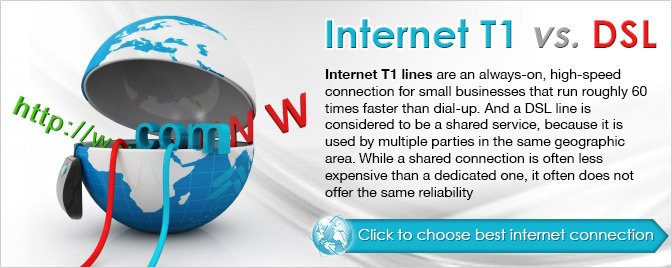Internet connections are the lifeblood of today’s businesses. As companies grow to depend on their Internet connectivity, it becomes more and more crucial that their connection is not only cost efficient, but strong and reliable.
One of the most common Internet connections used by small businesses is an Internet T1 connection. Internet T1 lines are an always-on, high-speed connection that run roughly 60 times faster than dial-up and are typically run over copper telephone lines that are already installed in most businesses. An Internet T1 connection can carry data at a rate of 1.544 megabits per second or carry 24 digitized voice channels.
Another frequently used high-speed connection is DSL, which stands for Digital Subscriber Line. Like an Internet T1 line, a DSL line is run over the same copper POTS (Plain Old Telephone Service) wires that are in just about every business building already. That being said, a DSL connection is really only adequate for a home office or a business with less than a handful of employees; and there are a number of reasons why.
To start, a T1 line is considered to be a dedicated service, because it is used solely by the customer and no one else. The benefit of a dedicated service is that you receive the full amount of bandwidth for both uploads and downloads at all times during the day night. This is also why Internet T1 connections typically cost more than DSL.
On the other hand, a DSL line is considered to be a shared service, because it is used by multiple parties in the same geographic area. While a shared connection is often less expensive than a dedicated one, it often does not offer the same reliability. This is because, as a general rule of thumb, the less expensive the DSL line, the more likely it is to be oversubscribed (aka used by a large number of other users). While the price might seem attractive, you will more than likely suffer from speeds so slow you are unable to run your daily operations properly, especially during peak hours. For example, many DSL providers will state that they offer speeds of 20Mb or more, however this is split between all of the users that are sharing the service with you. As a result, during high traffic hours where there are a large number of users accessing the circuit, the speeds will drop dramatically – often resulting in a bottleneck effect.
Image Source : cooldesign / FreeDigitalPhotos.net


